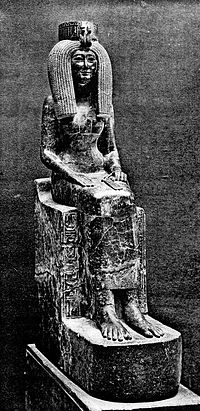Isis (King Wife)
| Isis (king's wife) in hieroglyphics | |||||||||||||
|---|---|---|---|---|---|---|---|---|---|---|---|---|---|
| 18th dynasty |
Is.t Isis |
||||||||||||
| Seated statue of Isis in the Egyptian Museum in Cairo (JE 37417 or CG 42072) | |||||||||||||
Isis was a concubine of the ancient Egyptian King ( Pharaoh ) Thutmose II and mother of King Thutmose III. in the 15th century BC After the death of her husband and during the reign of her son, she was subsequently elevated to the status of a Great Royal Wife . It is named after the ancient Egyptian goddess Isis .
The marriage of Thutmosis I and Ahmose came from Hatshepsut , the heir to the throne Thutmose II, however, from the marriage with the concubine Mutnofret . The half-sister Hatshepsut became the main wife of Thutmose II, presumably in order to preserve the “pure blood” and to legitimize the claim to the throne. The heir to the throne Thutmose III. However, came from the marriage with the concubine Isis, about whose origin almost nothing is known. Isis probably came from a noble family with good connections to the royal family. Angelika Tulhoff suspects that she was accepted into the royal women's palace as a token of favor from the king.
A well-known representation of Isis can be found in her son's grave ( KV34 ). There she is in the same boat with him and is accompanied by other family members of the king. In addition, an unusual scene is briefly sketched: A stylized tree extends the king's breast with the inscription: “He sucks on (the breast) of his mother Isis”. Since Thutmose's mother was actually called Isis, the scene could ostensibly be interpreted as the return of the king to his mother and rejuvenation, but the tree suggests a goddess who otherwise grows out of the tree in the official graves as Nut or Hathor and the dead with his bird-shaped ba offers cool water and offerings. That Isis is called here instead is due to the name of the earthly mother and the myth according to which the king represents the role of the god Horus on earth and returns to the protection of his divine mother Isis, who cares for and protects him.
A 98.5 cm high, black granite statue from the "Cachette of Karnak " (see also the discovery of the cachette by Georges Legrain ) is now in the Egyptian Museum in Cairo (with inventory number JE 37417 or CG 42072). The statue was donated by her son. Isis sits on a throne in the traditional way. She wears a wig with fine curls, a gold-plated diadem and on her forehead two uraeus snakes , each with a white and red crown . She wears a tight dress and a Wesech collar . She holds a lotus scepter in one hand. On the front of the throne is a dedication inscription from Thutmose III. to his mother Isis to read: "The perfect God, Men-cheper-Re, loved by Amun-Re , Lord of the Thrones of the Two Lands, he made a monument to his mother, Queen Mother Isis, justified ."
Individual evidence
- ^ Aidan Dodson , Dyan Hilton: The Complete Royal Families of Ancient Egypt. The American University in Cairo Press, Cairo 2004, ISBN 978-977-424-878-8 , p. 138.
- ^ Thomas Schneider : Lexicon of the Pharaohs. Albatros, Düsseldorf 2002, ISBN 3-491-96053-3 , pp. 289f.
- ↑ G. Höber-Kamel: Thutmose III. Life and work of a great king. In: Kemet. Vol. 10, No. 3, 2001, p. 6; Angelika Tulhoff: Thutmose III. 1490-1436 BC BC: the Egyptian empire at the height of power. Callwey, Munich 1984, ISBN 978-3-7667-0709-3 , p. 42.
- ↑ Erik Hornung : Valley of the Kings. The resting place of the pharaohs. 3rd, extended edition, Wissenschaftliche Buchgesellschaft, Darmstadt 1985, p. 85
- ^ M. Georges Legrain: Statues et Statuettes de Rois et de Particuliers. Catalog Général des Antiquités Égyptiennes du Musée du Caire. Nos 42001-42138. Imprimerie de l'Institut Français d'Archéologie Orientale, Cairo 1906, pp. 41–42, plate 42.
- ↑ Abeer El-Shahawy, Farid S Atiya, Matḥaf al-Miṣrī: The Egyptian Museum in Cairo. A walk through the Alleys of Ancient Egypt. Farid Atiya Press, Giza 2005, ISBN 978-977-17-2183-3 , pp. 171-172.
- ↑ The main works in the Egyptian Museum in Cairo. Official catalog. Published by the Antiquities Service of the Arab Republic of Egypt. von Zabern , Mainz 1986, ISBN 3-8053-0640-7 ; ISBN 3-8053-0904-X (museum edition), No. 137.
| personal data | |
|---|---|
| SURNAME | Isis |
| BRIEF DESCRIPTION | Concubine of the ancient Egyptian king (Pharaoh) Thutmose II and mother of king Thutmose III. |
| DATE OF BIRTH | 16th century BC BC or 15th century BC Chr. |
| DATE OF DEATH | 15th century BC Chr. |

